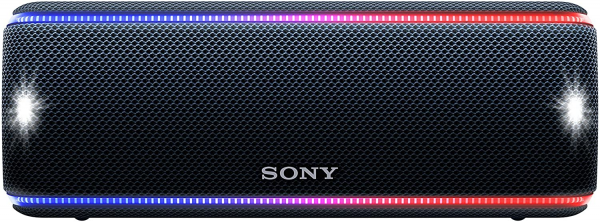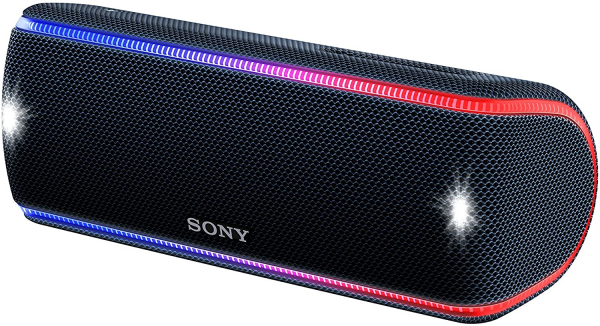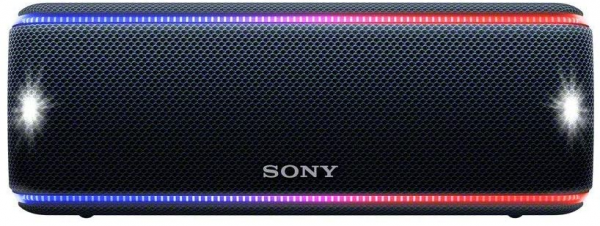Sony
Portable speaker Sony SRS-XB31: always more design, always more resistant
Aprox. 99€
See specificationsA member of the second generation of Sony's "Extra Bass" portable loudspeakers, the SRS-XB31 succeeds the SRS-XB30 in the catalog of the Japanese giant. Taking up the basics of its predecessor, it still manages to bring him some innovations that are certainly subtle, but not insignificant.
Positive points
Its powerful and dynamic.
Excellent precision, very low distortion.
Beautiful bass extension, efficient "Extra Bass" mode.
Complete mobile application.
Very robust construction, resistance to water and dust (IP67 certification), resistance to falls.
Design worked.
Good autonomy.
USB-A socket for recharging a mobile device.
Bad points
You have to go through the equalizer of the mobile application to get a good sound balance.
Extreme acute in all cases a little too far back.
High Bluetooth latency.
The synchronization of light effects with music leaves something to be desired.
Our review
Audio
In audio as elsewhere, the SRS-XB31 has only few surprises in store for us, since it offers a sound close to that of the XB30. So here we find a powerful reproduction, certainly quite colorful, but which impresses with its precision and its mastery of distortion.
In "standard" sound mode, the XB31 offers, like its predecessor, a rendering that is substantially concentrated towards the midrange, around 800 Hz. This type of reproduction is particularly effective when it comes to accentuating the sensation of sound amplitude, even coming from a miniature speaker. It is also quite flattering for voices, which is why it is often associated with audio products such as home cinema - regulars of Bose home cinema mini speakers, for example, will certainly feel on familiar ground. On the other hand, we can also criticize this rendering for being not very musical: the frequency zone put forward corresponding to the first harmonics of the medium sounds, it exaggerates the timbres, makes the overall sound quite rough and grainy, lacking roundness.
Don't panic, however, there is a very simple solution to this problem: activate the "Extra Bass" mode. Far from indulging as one might have feared in muddy and enlarged bass, this mode only very aptly adds a little presence to the lower part of the spectrum. We then appreciate a fairly remarkable extension compared to the size of the speaker: the passive bass radiator manages to go down to 60 Hz without causing major resonances. The only counterpart to note is at the level of the distortion: almost non-existent in standard mode, it rises very slightly above the threshold of the audible in Extra Bass mode. The thing remains however largely bearable.
In spite of everything, the auditory attention then remains very slightly focused on the midrange - consequence of the gradual attenuation of the high midrange and treble. But then again, if the thing is not to your liking, a remedy exists: set the mids to -5 in the equalizer. We then end up with an almost constant attenuation from the low mids to the treble extremes, which gives the sound a very soft and warm character - with the exception of the peak at 15 kHz, more or less audible depending on the state of the hearing each.
In all cases, the sensation of details and sound energy remains excellent, thanks to the excellent precision of the rendering, and especially to its dynamics. From this point of view, the XB31 has progressed significantly compared to the XB30: while we criticize the latter for overwriting the signal a little, its replacement reproduces with impeccable velocity the blows of snare drums and other sounds very frank attacks. One condition: do not exceed 66% of the maximum volume, beyond which a slight dynamic compression is triggered; rest assured, the listening volume is already very generous.
Remain to evoke the case of the mode "Live", another innovation brought by the XB31. Behind this name hides in reality a virtual spatialization treatment, which aims to broaden the stereophony clearly beyond the dimensions of the enclosure. And it must be recognized that this objective is fulfilled in a resounding way: the sound scene then takes on frankly surprising dimensions, without losing its naturalness! Unfortunately, the price to pay to get there is heavy: the precision that we have so much praised above takes a hit, victim of a small surge in distortion, especially in the low frequencies. Generally speaking, we therefore prefer to stay in "Extra Bass" mode - all the more so since the stereophony remains very correct for a portable speaker.

Conclusion
Very similar to the XB30, the SRS-XB31 from Sony still manages to make improvements far from insignificant. Improved water resistance (IP67 certification), sophisticated design and very solid audio reproduction are on the program for a bright portable speaker that is more attractive than ever.

Specifications

